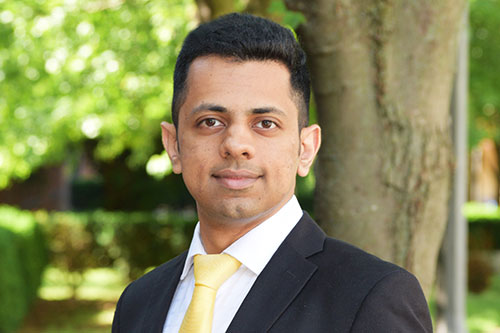By Stephen Greenwell
Three new assistant professors recently joined the civil and environmental engineering department at the Cullen College of Engineering — Dr. Vedhus Hoskere, Dr. Xie Hu and Dr. Dimitrios Kalliontzis.
 Vedhus Hoskere |
Hoskere will start the Structures and Artificial Intelligence Lab (SAIL) at the college.
“The research will span the broad area of artificial intelligence applications in structural engineering,” he said. “My doctoral work at the University of Illinois with Billie F. Spencer Jr. focused on developing artificial intelligence, machine learning and computer vision solutions for rapid and automated civil infrastructure condition assessment.”
He completed his doctorate in civil and environmental engineering this summer, along with a M.S. in computer science at the University of Illinois at Urbana-Champaign earlier this year in May. He earned a M.S. in civil and environmental engineering from there in May 2016, and his B.S. in civil engineering was completed at the B. M. S. College of Engineering in Bengaluru, India back in May 2014.
In the aftermath of natural disasters like earthquakes, fast and reliable assessment of structures is crucial to allow people to resume occupation of their homes and offices with delays severely exacerbating economic and societal disruption. To mitigate these problems, Hoskere’s research investigates development of an automated inspection framework for buildings and viaducts using drones and deep learning methods. He has also worked closely with the U.S. Army Corps of Engineers to develop solutions for automated inspections and monitoring of navigational locks and dams that form a crucial part of the inland navigation system. In his free time, he enjoys singing Indian classical music, swing dancing, flying drones, and going on runs and hikes.
 Xie Hu |
Hu will be working at the National Center for Airborne Laser Mapping, which she described as a well-known geosensing institution and a draw when applying for a position.
“The strength of LiDAR and multiple remote sensing techniques, as well as engineering and environmental expertise, help establish an ideal platform for interdisciplinary studies,” she said. “The CEE department and the university are extremely supportive. The mutual respect and appreciation within an institute are necessary for good science and research, and also for my career development. That’s what brought me here.”
Hu uses radar imagery, taken from satellites or aircrafts, to measure the ground motion within millimeter accuracy.
“This approach can be used to monitor various kinds of geohazards, and the Earth’s shallow and deep processes associated with natural or anthropogenic triggers, such as landslides, earthquakes, aquifer systems, mining, oil and gas production and groundwater pumping,” she said.
Hu earned her Ph.D. in geophysics from Southern Methodist University in 2018. She received a master's in remote sensing from Wuhan University in 2014, and her B.E. in GIS from the China University of Geosciences (Wuhan) in 2011. Prior to being hired by UH, Hu worked as a postdoctoral researcher at the University of California, Berkeley. In her free time, Hu enjoys spending time with her family and friends, as well as traveling.
 Dimitrios Kalliontzis |
Kalliontzis said the University of Houston's continued improvement was a reason it appealed to him.
“Year by year, the Cullen College of Engineering rises in the US News & World Report rankings, which shows momentum when it comes to advancing its position in the map of research and teaching innovations,” he said. “This is a great environment for a young faculty to be in, in order to seek academic growth and contribute to the college’s endeavor for excellence.”
He added, “The Department of Civil and Environmental Engineering offers a great teaching and research environment with unique experimental facilities for structural testing. The department has a long history of experimental and computational research in the area of concrete structures, offering great collaborative opportunities for a young faculty member whose research vision is along the same lines.”
Kalliontzis said his research combines computational modeling techniques with laboratory testing to better understand how critical structures behave under extreme loading conditions.
“What would be the consequences of an earthquake, tsunami or hurricane hitting our homes, hospitals or other critical structures, especially amid a pandemic? Can we design these structures to resist natural hazards without experiencing any damage?” he said. “Using the generated knowledge, my research develops new concepts for designing new structures and for retrofitting existing ones.”
Kalliontzis received his doctorate in structural engineering from the University of Minnesota, Twin Cities, in August 2018. He earned a master's in structural engineering from Iowa State University in August 2014, and received his diploma in civil engineering from the Aristotle University of Thessaloniki in Greece.
Since earning his doctorate, Kalliontzis has been a postdoctoral researcher at the University of California, San Diego. In his free time, he enjoys traveling, running, spending time with his family, and reading books about history, cosmology and religion.